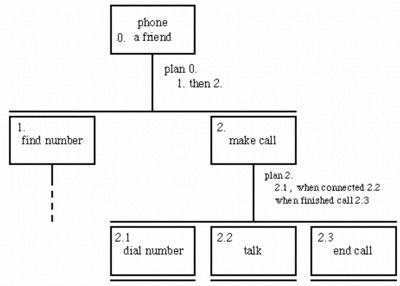This exercise is based on the mobile phone scenario on the web at: www.hcibook.com/e3/scenario/phone/
A user interface designer analyses Andy's behaviour with his original phone and realises that both scenarios A and B are part of a general pattern as shown in the Hierarchical Task Analysis (HTA) in Figure 15.8.
(i) Complete the HTA for phoning using
the original phone taking into account scenarios A
and B only and briefly describe your solution.
(ii) Do a complete HTA for phoning using the new phone
based on scenario C only
(iii) You will find that scenario C (and hence your
solution to part (ii)) does not quite fit into the
general pattern in Figure 15.8.
Discuss whether the solutions to (i) and (ii) can be modified to emphasise their common features and whether this would clarify the overall task description.

Figure 15.8. Rough HTA